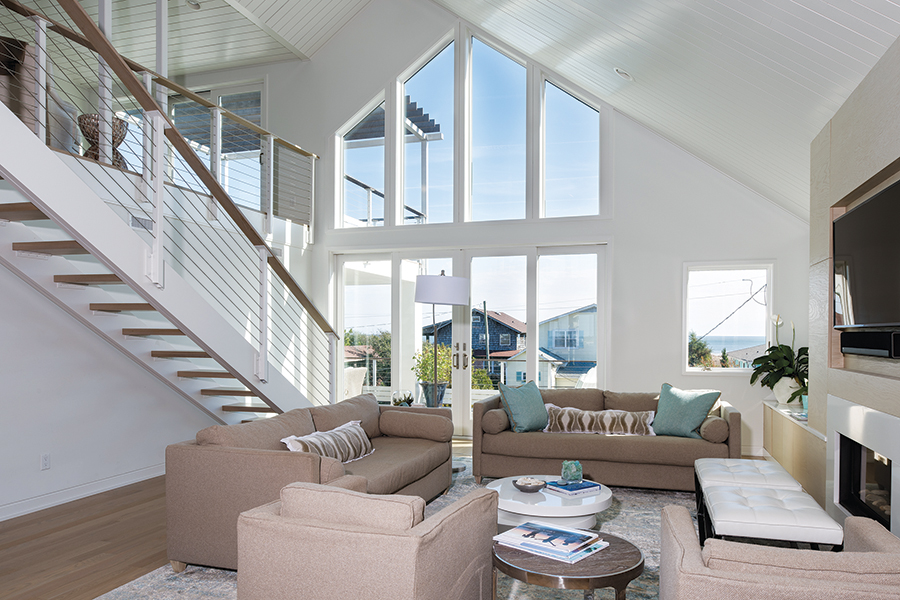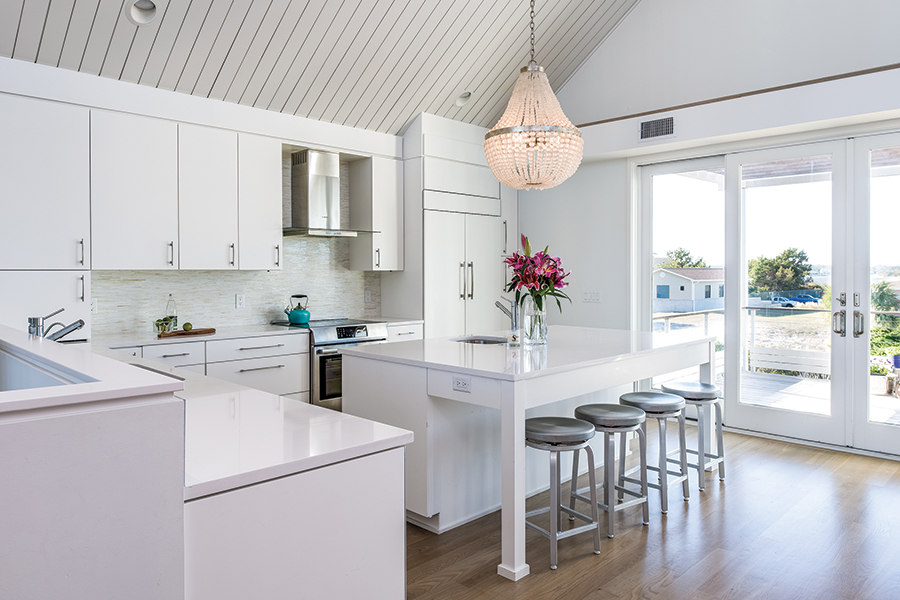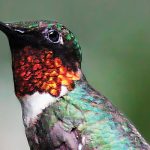A home with an eye on the horizon
By Isabel Zermani • Photographs by Rick Ricozzi
The South End of Wrightsville Beach is taking on a new, youthful character, something slightly less blue blood, with a spirited pioneering air, the same one that sweeps the island’s naked end to shape the dunes. It’s a great place to explore, shell hunt and windsurf; just ask the Andrews family. Their modern home on the tip of the South End is built to integrate both their lifestyle and the environment.
Dr. Hiroshi and Amy Andrews came to Wilmington seven years ago by way of “D.C., Korea, D.C., and Fort Gordon, Georgia,” says Amy. But first, “We met at Penn.” A Harvard University alum, Hiroshi was then in medical school at the University of Pennsylvania, and Amy was an undergrad on her way to becoming an ICU nurse. “We were in debt up to our eyeballs,” Amy says with a laugh. “Then my husband took this military position.”
The travel began; some places were better than others.
An avid windsurfer and paddle-boarder, Hiroshi couldn’t always walk out his front door to catch waves. “The years he spent dragging his stuff an hour from D.C. to some crappy beach in Baltimore — he’s earned it!” says Amy while touring Hiroshi’s gear collection on the ground level. The windsurfing sails are hung from ceiling hooks like colorful bats in this man cave, but living at the beach was truly a family dream. When the job opportunity in Wilmington arrived, they jumped on it and moved near the hospital, but “we were always coming to the beach.”

They got a plan.
“Building the house was the 10–15 year plan, then the five–10 year plan. . . then the now plan,” remembers Amy.
It’s not an exaggeration to say this house was built around ocean views. The open concept living space is two stories tall with an east wall that’s mostly glass. The cathedral-like windows come to a point, worshipfully framing the Atlantic rolling over the jetty. Amy wanted to see water at all times, as “close to being outside as possible,” but “we didn’t realize we’d have such great views.” The architect, John Parker, remembers being stunned too: “Gosh, Amy, I feel like I’m in church.”
Or perhaps, the world’s nicest yoga studio.
Upstairs, in the open loft above the living room, is “the yoga spot,” points out Amy, a yoga teacher for the last five years. The loft’s glass doors slide open to a deck with uninterrupted views — pier to jetty — that is the warm weather yoga spot. There are three levels of decks, making the outdoor living space nearly as high a priority as the indoor, and not just for their Labradoodle, Harry Potter. In the original plans, a four-story outdoor spiral staircase connected each deck, but during construction, it was ruled out, keeping each deck level somewhat private.
Changes happen during construction. The two-year build of this home (one year planning, one year building) felt “the way it used to be” for Parker, with client, builder Ralph Konrady, and architect “all together, on the ground.” The position of the staircase in the living room was reconfigured to hug the wall, not be a centerpiece, and an upstairs storage closet became an extra bathroom. How you want your house is driven by how you live, not the other way around, at least not for Parker, who is now designing his third house on the South End. He doesn’t have a signature, but if he did, it might be the facing windows wrapping the southeast corner, maximizing those South End views. First star to the right and straight on till Masonboro. . .
Eastern thought influenced both the design and furnishing of their home. “I wanted basically no furniture, all built-ins. White. Light wood. The less stuff, the better,” says Amy. It could be Amy’s yogic ways, Hiroshi’s Japanese heritage, or all the moving that comes with military service that instilled a love of simplicity, but the result is cerebrally soothing. The Zen of the limited palate: “It was a running joke when building the house; the guys would ask, ‘What color will this be?’ White. Always white.”

While modernism can be severe, this home is softened in skillful ways. The lighting fixtures in the kitchen and dining room offer warm white and organic forms. The kitchen tile — a much-wrought-over choice — recalls the natural sheer of shells, adding depth. The brushed finish of fixtures throughout the house keeps the linear forms light and soft. The dining room chairs, though still white, “are one of the few things from the old house,” says Amy, “and they add a little texture.” Interior design-wise, Amy is quick to mention Big Sky Design, but also, “I have a tendency to go my own way.”
On the other end, one of the main traditional elements of the house is the gabled roof. (The south side is covered in solar panels.) Though initially drawn to John Parker by his design of a very modern house five doors down, the Andrewses wanted “a blend” of modern and traditional, “especially on the outside.”
We often think of building as being from the ground up, but starting at the top has its benefits. Parker worked the ceilings into the gabled roofline, creating an even greater sense of space by the vertical wood covering on the ceiling. The almost-invisible cable railings on the stairs and loft subtly interplay with the ceiling; the cable’s linear stripes mirror the plank seams.
An unlikely centerpiece to the room was also driven by views — the elevator. Parker explained that Amy had wanted an open concept, but some privacy in the kitchen. “I make a mess in my kitchen. I have four kids!” she chimed in on the topic. Once they were in the space, it was different; the eyeline from the sink didn’t have an ocean view. Parker recalls Amy arriving at the solution: “‘How about a glass elevator?’ She came up with it. It’s more or less custom-made.” They found a commercial company that could do it and preserve those views. You even get the view of the inner mechanics of the elevator, reminiscent of a bank vault.

Amy’s favorite view? It’s from the square Japanese soaking tub in the master bath. “The sun sets right there,” Amy points through an already picturesque view of the quiet sound with swaying grasses. (Even as the South End builds up, this view will likely remain, as their back neighbor is the one-story Coast Guard building.)
Connecting the master bedroom and bath is what Parker calls “a walk-through” closet, not a walk-in. The lots on Wrightsville Beach are narrow, he explains, which calls for creative carving of the space. It’s a hallway of built-in cabinets in a modern finish. “It conceals everything,” say Amy with delight.
The master bedroom has built-ins, too, keeping the consistent, polished look. Above the bed hangs an expressive nude by local painter Jay Edge. When the Andrewses deviate from concentrated calm, it’s with good reason. “I only put something on the wall when it means something to me,” says Amy. The Chip Hemingway landscape painting of the South End from the inlet holds court in the dining room, and the living room chess nook features an antique map of Kyoto, Japan, where Hiroshi was born.

Downstairs on the first floor are the children’s and guest bedrooms, as well as a playroom that opens out to the backyard, previously home to a half-pipe, currently home to the soccer field, and soon home to a pool. “Here’s my fake grass!” Amy says cheerfully. “No chemicals, no water.” This is an eco-friendly soccer field. Next door is an empty lot for when the three boys want to play full court. Their eldest child is a daughter with artistic, environmental and sustainability interests, as demonstrated by her brightly colored room and cow paintings — she’s vegan. The family has a “plant based diet,” which Hiroshi, as a gastroenterologist, also supports. In the driveway is a Tesla. The Andrewses are thinking about the future.
The Andrews family have been in their dream-house-turned-now-house exactly one year and the gratitude has not worn off.
“We never take it for granted,” says Amy; she wears a white tank top with metallic letters that say: Work your Out. “We use the beach. We walk and pick up trash all year long.” With four kids, they can probably cover some real ground.



